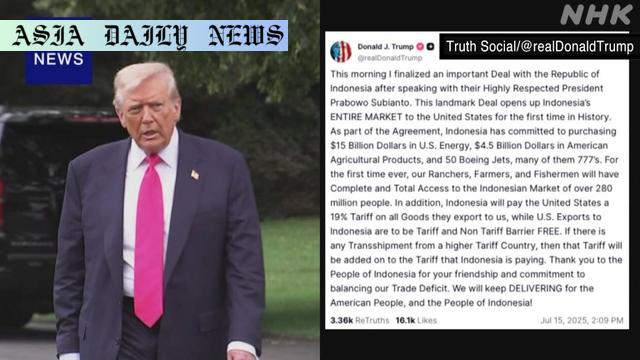Tariff: US President Donald Trump announces a 19% tariff on all Indonesian imports to the US, with trade benefits for US exports.
The US finalizes a new trade deal imposing a 19% tariff on all Indonesian imports.
Indonesia commits to purchasing $15 billion in US energy, $4.5 billion in agriculture, and 50 Boeing jets.
The deal allows tariff-free and barrier-free access for US exports to Indonesia.

A New Tariff Structure Between the US and Indonesia
The United States and Indonesia have reached a significant trade agreement highlighted by a new 19% tariff on all Indonesian imports entering the US. President Donald Trump announced this development on Tuesday, emphasizing its transformative impact on bilateral trade relations. According to the deal, US exports to Indonesia would benefit from tariff-free and non-tariff barrier-free access, a stark contrast to the restrictions that previously existed.
This deal replaces a higher tariff rate of 32%, which was initially planned to take effect in August. The administration had intended to levy a 10% universal tariff as well as “reciprocal tariffs” totaling 32%, but the new agreement has streamlined the rates and improved commerce opportunities for both sides.
Massive Commitments from Indonesia
Pivotal to this agreement is Indonesia’s commitment to economic partnerships with the United States. As part of the conditions, Indonesia has agreed to major purchases of US goods and services, including $15 billion in US energy products, $4.5 billion in agricultural produce, and the acquisition of 50 Boeing jets. Such commitments underscore Indonesia’s intent to foster closer economic ties with the US while benefiting from the revised tariff structure in their favor.
The capital exchange implied by this deal indicates a win-win for both economies, paving the way for deeper collaborations in strategic industries. Indonesia’s agreement to these sizable purchases highlights the value of American output in global markets.
Long-Term Implications of the Agreement
This deal is poised to have long-term economic implications by removing pre-existing barriers to trade and opening markets for US exporters. Trump emphasized the US now has unrestricted access to Indonesian markets, which was notably absent before this agreement. This could signal a shift in the trade balance, benefiting multiple sectors of the US economy, particularly manufacturing, agriculture, and aviation.
For Indonesia, the deal may enhance its economic investments but simultaneously leaves their exports subject to significant tariff costs. Whether this will have a detrimental long-term impact on their businesses will depend on how effectively they adjust to the new terms and leverage their increased purchases from the US to breed further domestic economic growth.
Overall, the 19% tariff agreement marks a new era of trade relations between the two nations, setting a benchmark for future negotiations.



Commentary
Analyzing the Strategic Value of the Agreement
The current trade agreement between the United States and Indonesia signifies a major shift in economic diplomacy, with both parties achieving considerable benefits. For the US, imposing a 19% tariff reinforces its economic position, signaling a firm stance on boosting local industries and reducing trade deficits. At the same time, granting Indonesia tariff-free and non-tariff restrictive access highlights America’s willingness to compromise for reciprocal gains.
The Importance of Reciprocity in Modern Trade
Reciprocity, as demonstrated in this agreement, is the cornerstone of modern trade deals. Through Indonesia’s commitments to invest heavily in American energy, agricultural, and aviation industries, the US clearly gains robust assurances of financial returns. This deal exhibits President Trump’s negotiation style, which prioritizes immediate, tangible economic outcomes that bolster domestic productivity.
Forecasting Economic and Political Consequences
From a political perspective, the deal reinforces Trump’s narrative of securing “better deals for America”, resonating with his core voter base. Economically, industries such as agriculture and aviation may witness a significant boost given Indonesia’s specific purchasing commitments. On the other hand, the imposed tariffs could create hurdles for smaller Indonesian exporters and require substantial renegotiations in the future to maintain mutual satisfaction for both nations.
Ultimately, time will tell if this deal creates lasting economic harmony or raises unforeseen challenges. However, it serves as a critical example of how bilateral trade agreements can reshape global commerce dynamics significantly.